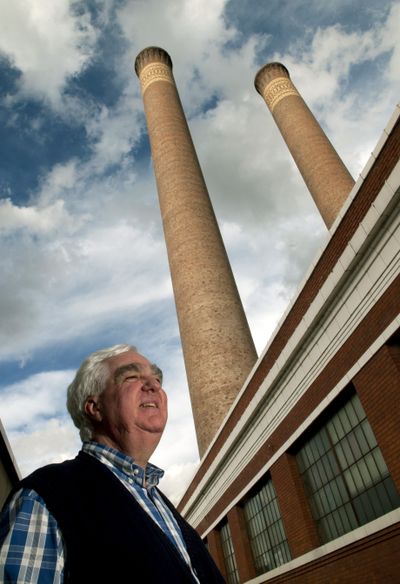Wells and Co. has been revitalizing cityscape for decades

Preservation architect Ron Wells dreams of putting an observation deck on top of one of the old Steam Plant stacks that tower 225 feet above downtown Spokane.
Based on his history of finishing major restorations across the region, Wells’ dream is believable.
He just needs to figure out how to get an elevator up the inside of the cavernous stack and attach a platform on the skyward opening, he said.
Wells and his wife, Julie, are owners of the city’s premier historic restoration firm – Wells and Co. – with 41 certified historic restorations to their credit.
They moved their business to Spokane in 1983 for one reason: “Spokane was a treasure trove of underappreciated buildings,” said Wells, a graduate of North Carolina State University.
But their arrival was good timing. The city’s young preservation movement was just emerging, with creation of a City/County Landmarks Commission three years earlier.
Since then, the Wellses have brought back elegant old apartment buildings such as the San Marco; turned warehouse spaces into living units such as the Lofts at Joel, 165 S. Post St.; converted a mid-20th-century motel at First Avenue and Lincoln Street into the Courtyard Office Center; and cleaned up an old laundry for what’s now Italia Trattoria restaurant in Browne’s Addition.
The McConnell Building in Moscow and the Brier Building in Lewiston are also the Wellses’ work.
When asked to name their best project, Ron Wells responded with a question: “How do you pick your favorite child?”
But the favorite child is clearly the old Spokane Central Steam Heat Plant, an award-winning enclave that now houses a restaurant, brewery and offices.
Delegates to this week’s National Preservation Conference will get their chance to see today’s Steam Plant Square, at 159 S. Lincoln St. As many as 1,700 delegates were expected in Spokane, although cancellations were occurring in the aftermath of superstorm Sandy.
Kristen Griffin, Spokane’s historic preservation officer, said, “It takes a certain kind of person” for historic restoration.
“It takes more than money. It takes more than talent,” she said. “It takes creativity and a real desire to bring a project to completion.”
“He typifies that,” she said of Wells.
The Steam Plant’s pipes, grates, fittings and odd metal shapes offer an intimate look at the heart of industrial America. You can eat inside the belly of an old boiler or marvel at the patterns of severed manifold pipes.
“As many times as I’ve been in here, the shapes are always intriguing,” Wells said. “None of us realized the extent that this steam plant was unique.”
From 1916 until 1986, the steam plant supplied heat through underground pipes to as many as 320 customers at one point. The plant’s boilers were fired by three rail car loads of coal each day.
The brick exterior retains the grace of architects Kirtland Cutter and Karl Malmgren, who used a Renaissance Revival style for the building.
Wells said the restoration that began in 1997 included careful evaluation with an eye toward saving existing features. Julie Wells is an interior designer.
Pieces that were removed ended up as benches and artwork along city sidewalks.
The venture has proven financially successful. Revenue at the restaurant and brewery is up 39 percent this year, allowing for an investment of $400,000 in new interior finishes, he said.
“The whole idea of sustainability is keeping what you have and using it,” he said. “This found a new life completely apart from what we had.”
Next up: A remotely located air intake room may one day be converted into a cigar room, and will comply with Washington’s smoking-in-public-places law, Wells said.
Wells doesn’t want to take too much credit for leading historic preservation in Spokane. He is quick to recognize others, such as:
• Walt and Karen Worthy, who brought back the Davenport Hotel.
• Rob Brewster, who renovated the Montvale Hotel at First Avenue and Monroe Street and the Holley Mason Building, 157 S. Howard St.
• Steve Schmautz, who resurrected the American Legion Building at 108 N. Washington St.
• Jerry Dicker, who has taken on the old Burgan’s Furniture building restoration, the Bing Crosby Theater and the artsy Hotel Ruby.
Neighborhood restoration has been impressive, too, Wells said. For example, Mary Moltke in Browne’s Addition recently opened EJ’s Bistro at Pacific Avenue and Cannon Street next to her Roberts Mansion bed-and-breakfast and events facility, he said.
Chris Batten and Jerry Mauer are among leaders in restoration of residential and commercial spaces, Griffin said. Joe Dinnison created Hotel Lusso from the Miller and Whitten buildings at 808 W. Sprague Ave.
“Ron has been the true trailblazer,” said Joanne Moyer, a co-chair of the preservation conference.